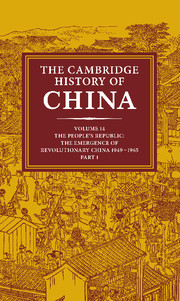Book contents
- Frontmatter
- 1 The reunification of China
- PART 1 EMULATING THE SOVIET MODEL, 1949–1957
- PART II THE SEARCH FOR A CHINESE ROAD, 1958–1965
- 7 The Great Leap Forward and the split in the Yenan leadership
- 8 The Chinese economy under stress, 1958—1965
- 9 New directions in education
- 10 The Party and the intellectuals: phase two
- 11 The Sino-Soviet split
- Bibliographical Essays
- Bibliographical essays for chapters
- Bibliography
- Appendixes: Meetings and Leaders
- Conversion Tables: pinyin and Wade-Giles
- Glossary Index
- Map 1. China’s physical features
- Map 2. PRC: political (Wade–Giles romanization)
- Map 3. PRC: political (pinyin romanization)
- References
9 - New directions in education
from PART II - THE SEARCH FOR A CHINESE ROAD, 1958–1965
Published online by Cambridge University Press: 28 March 2008
- Frontmatter
- 1 The reunification of China
- PART 1 EMULATING THE SOVIET MODEL, 1949–1957
- PART II THE SEARCH FOR A CHINESE ROAD, 1958–1965
- 7 The Great Leap Forward and the split in the Yenan leadership
- 8 The Chinese economy under stress, 1958—1965
- 9 New directions in education
- 10 The Party and the intellectuals: phase two
- 11 The Sino-Soviet split
- Bibliographical Essays
- Bibliographical essays for chapters
- Bibliography
- Appendixes: Meetings and Leaders
- Conversion Tables: pinyin and Wade-Giles
- Glossary Index
- Map 1. China’s physical features
- Map 2. PRC: political (Wade–Giles romanization)
- Map 3. PRC: political (pinyin romanization)
- References
Summary
According to the conventional periodization of post-1949 China, the Great Leap Forward of 1958 marks the end of direct Soviet influence and the begining of a new Chinese road to socialism. Ironically, one of the major principles underlying the changes introduced into Chinese education at this time might well have been inspired by the critique of the “Stalin model” of education that developed in the Soviet Union after his death in 1953. Resolutions first adopted there in 1956 concerning the role of labor in education were not widely promoted in Soviet education until they were officially decreed in 1958. Known as the “Khrushchev reforms,” they aimed at closing the gap between education and practical life. In promoting them, Khrushchev complained that senior secondary school graduates who did not gain admission to college were unprepared for production work. “There are even certain young people,” he remarked, “who are unwilling to go to work in industry or farming, thinking it beneath them.”
The Soviet reforms of 1958 were therefore designed to prepare all secondary students for work regardless of when they terminated their schooling, and production training was included in the curriculum. At least 80 percent of the new students admitted to Soviet institutions of higher learning each year were to be enrolled from among those who had worked at least two years after finishing secondary school.
The Khrushchev reforms were never successfully integrated into the Soviet educational system, and did not survive the political demise of their chief advocate. In China, where a similar debate over labor education was also developing in the mid-1950s, the changes of 1958 had a more complex history.
Keywords
- Type
- Chapter
- Information
- The Cambridge History of China , pp. 398 - 431Publisher: Cambridge University PressPrint publication year: 1987
References
- 1
- Cited by

